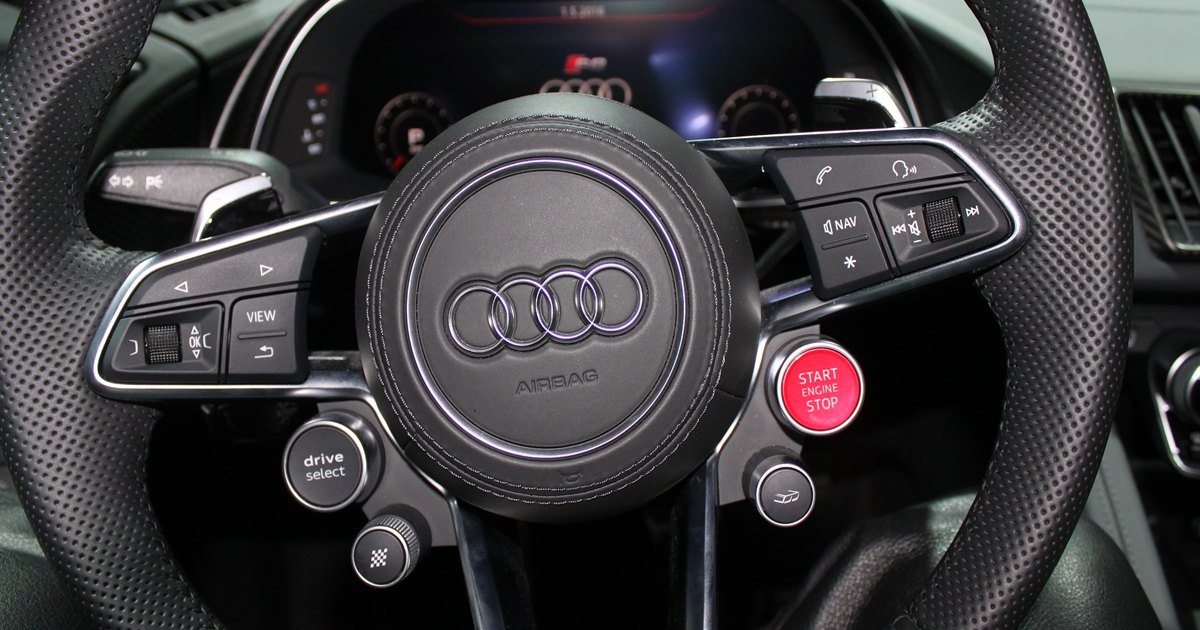
The steering wheel, also known as the driving wheel or the handwheel, is what you see in front of yourself when you sit on the driving seat. It is a part of the steering system of your vehicle, which helps you control the direction of your car.
While you may deem it a very simple interior component allowing you to swerve and turn, it is, in fact, one of the most crucial parts of your vehicle. In other words, you cannot drive your car without it, so it requires care and maintenance to function properly. Due to its critical role in the control of your car, keeping your steering system in good working condition is crucial to you and your vehicle’s safety while driving.
The question is how much do you really know about this component. How does the steering system work? What parts does it consist of? What do all these controls on the wheel do? Are you holding your driving wheel properly? Is your steering system failing? In this guide, we will answer all the questions you might have about your car’s driving wheel.
Let’s start with the basics:
How does your steering wheel work?
The primary function of your driving wheel is to transfer your input into the wheels of your car. When you turn your steering wheel, it makes the wheels rotate and face the direction you want to steer your car in. Steering systems vary from vehicle to vehicle but most of them operate on the same principle i.e., you rotate the handwheel, it moves the column, the shaft, and then other parts of the system.
The most common steering system you may see around is the Rack and Pinion, in which, turning the steering wheel causes the steering Pinion (gear) to churn along with another gear on the Rack (a long metal bar), connected to the wheels. It causes the wheels to turn. The size of the Pinion in relation to the size of the Rack determines the angle of the turn.
Most modern vehicles come with a power steering system. This type of steering uses a hydraulic system that enables you to perform the entire steering process with less energy. As a result, the steering mechanism becomes more responsive and vehicle control becomes more precise.
What is your steering wheel made of?
Your driving wheel may use different materials and styles, depending on your car’s make and model. However, the most common type of wheel consists of a metal ring covered with leather, wood, fabric, foam plastic, or any other such material, which improves your grip on the wheel.
In addition to this standard design, most modern cars now have buttons on their steering wheels. These control buttons make commonly used features more accessible to you, thus prevent you from getting distracted by having to fumble around for them. Steering controls are not a recent addition and have been a part of handwheels since the 1990s. Like all other car parts, however, these have also undergone great innovation. The most common controls on handwheels are:

1. Cruise control:
Cruise control is a useful feature for a straight road or highway driving. When you activate cruise mode, sensors in the front bumper automatically adjust your vehicle’s speed to regulate the distance between your car and the one ahead of you. This feature was among the first ones to move to the steering wheel. Not only can drivers activate this function from their handwheels, but they can also adjust the speed they want to cruise at.
2. Audio control:
Modern media controls on the driving wheel allow you to shift between radio, aux, USB, Bluetooth, and other media inputs. There is also an option to change radio channels or scan connected media and adjust the volume. Some of the more innovative vehicles have replaced volume control buttons with a scrolling wheel.
3. Phone call control
Most cars having a Bluetooth feature will also let you answer or decline phone calls by pressing the designated buttons on the handwheel. While this control isn’t yet commonplace in budget-friendly cars, it is useful and is becoming popular.
4. Steering wheel heating:
The heated driving wheel is a fun new addition to modern vehicles. The design consists of an electrically resistant coil that goes around the rim of the handwheel. These heaters warm up your hands and keep them from freezing. They’re particularly a source of comfort on long journeys in cold climates.
What is the proper way to hold a steering wheel?
While there are no hard and fast rules about how to hold and operate your driving wheel, there are a few good practices that you can observe for ease.
1. Place both hands on the handwheel; your left hand on the 9-position, and the right hand on the 3-position. Previously, experts would recommend using the 10 and 2 positions, but with the change in the shape of the handwheel, this position is now less common.
2. Firmly grip the wheel. Try not to hold on too tightly, as this might result in fatigued hands, which will make driving tedious during the long journeys.
3. Hold the handwheel with your fingers and not your palms.
4. Keep your thumbs on both sides of the wheel.
What are the signs of a failing steering system?
Since your steering wheel is such a crucial component of your car, you need to be extra vigilant when you start to have issues with it. Here are some tell-tale signs of a failing handwheel.
1. It feels stiff or gets stuck.
2. The steering wheel feels too loose.
3. It slips when turned.
4. You sense excessive vibration when you accelerate or turn the wheel.
5. Tires don’t start to move immediately as you turn the wheel.
6. You hear a grinding or screeching sound.
7. The handwheel feels off-center.
8. The wheel wobbles.
9. Your car drifts or pulls to one side.
10. The dashboard warning light comes on.
How to care for your steering wheel?
Handwheels are prone to wear and tear, but do not worry; there are ways to increase their durability and make them more responsive. Here are a few easy ways to achieve this:
1. Watch out for excessive “play” (reduces the responsiveness of the steering system).
2. Replace worn-out parts regularly since they can make your handwheel perform poorly.
3. Fix your vehicle suspension.
4. Upgrade to a better steering system.
5. Install add-ons that can make the steering process easier and put less strain on your steering system.
Conclusion:
The steering wheel is a fundamental part of your vehicle. It is the main connection you have with your car and the road while driving. It is crucial to understand how it works in order to care for it suitably. Make sure you deal with any signs of a failing steering system you notice immediately. You will not always have to replace the entire steering system; sometimes, it requires small component repairs to fix the issue. However, a timely replacement will go a long way and can save you and your car from harm.


